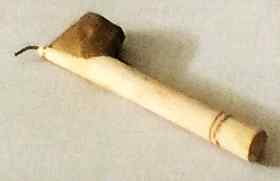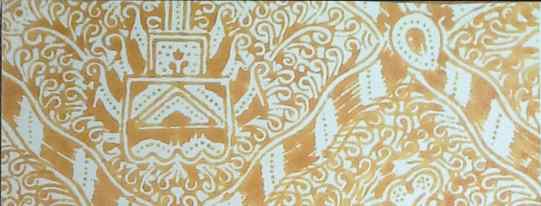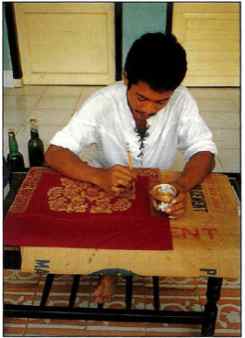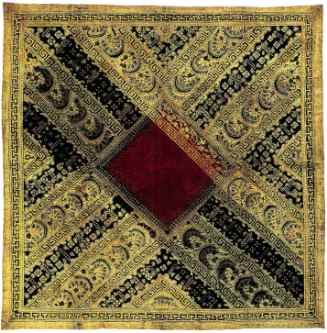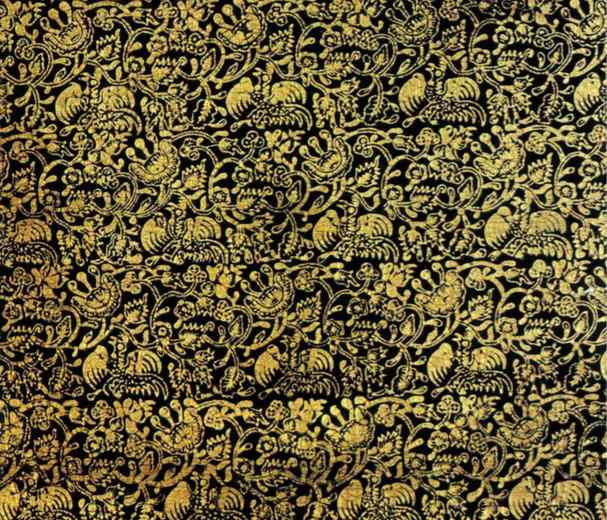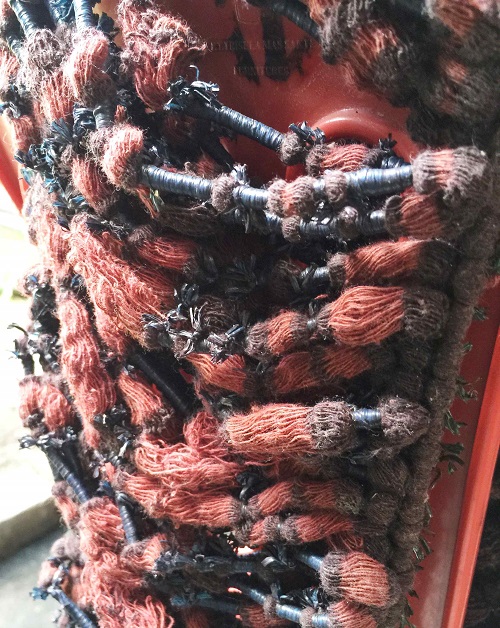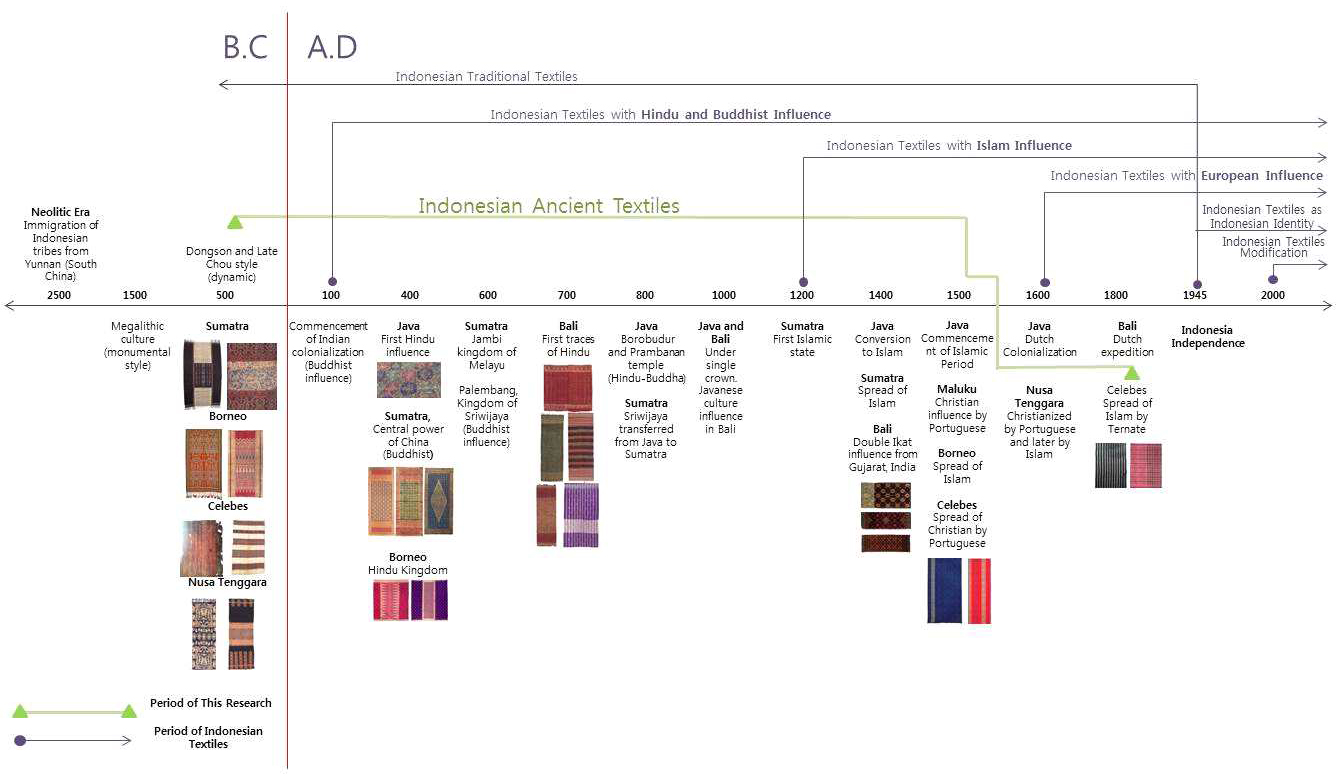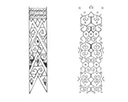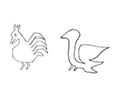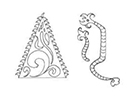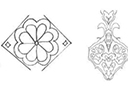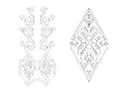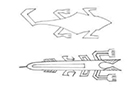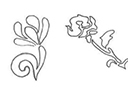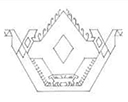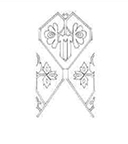
An Analysis on Characteristics of Ancient Indonesian Textiles (II) : Focus on the Techniques and the Patterns of the ‘Sacred Cloths’
Abstract
The ancient ‘sacred cloths’ of Indonesia have diverse characteristics. The purpose of this study is to analyze the characteristics of ancient Indonesian textiles, focusing on ‘sacred cloths.’ The research is divided into two parts. The first part analyzes the creation period, religious importance, region where the cloths are found, and color of the ‘sacred cloths.’ The second part focuses on the textile-making techniques and the ritual patterns of the ‘sacred cloths.’ This research is the second paper. This research analyzes 225 Indonesian sacred cloth examples chosen for their religious function in ceremony, and reviews 10 books and 8 research papers. Field research was done in the Museum of Bali, the Indonesian Museum of Textiles, and nine weaving production houses in eastern Bali. Indonesian sacred cloths express their cultural philosophy and function through production techniques, colors, techniques, and visual patterns. The ‘sacred cloth’-making techniques are classified as Batik, Prada, and Ikat. The regions that contribute to the textile production determine what patterns show up on the cloths. Sumatran patterns are philosophical, lavish, and prestigious. Bornean patterns are barbaric and prestigious. Balinese patterns are complex, decorative, warm, festive, calm, and aristocratic. Javanese patterns are symbolic and repetitive. Celebes patterns are artistic and simple. Nusa Tenggara patterns are symbolic and narrative. The forms shown on the textiles, whether geometric, human and animal, natural objects, or abstract patterns, determine how to classify the varied patterns. As a result, ancient Indonesian sacred cloths characteristics portray Indonesian identity as Bhinneka Tunggal Ika(Unity in Diversity).
Keywords:
ancient indonesian textiles, characteristics, patterns, sacred cloths, techniques키워드:
고대 인도네시아 직물, 특징, 패턴, 신성직물, 테크닉Ⅰ. Introduction
This chapter introduce the background information, literature review and research proposition, and research aim and methodologies of this paper.
1. Background Information
Indonesian textiles developed over time. Since 2500 BC, Indonesia has created basic weaving by a plaiting technique that were used for daily storage instead of clothing(Kartiwa, 1987/1993). However, the Dong Son era in 500 BC marks the first important change in Indonesian textiles through cloths depicting distinctive geometric patterns, advanced warp techniques used, and their religious functions. Animism, Buddhist-Hinduism, and Islamic kingdoms influenced ancient Indonesian textiles, leading to broad textile diversity from 500 BC until AD 1800.
Textile development was important to regional inter-island and international trading(Kahdar et al, 2010). The Sumatra, Borneo, Java, Celebes, Nusa Tenggara, and Bali regions participated in textile production.
Indonesia is a religious country. Textiles in Indonesia changed from solely utilitarian use to including bearing sacred meanings. Indonesian textiles are divided into secular cloths and sacred cloths. Secular cloths are for daily wear, while sacred cloths possess a certain power. Despite their contrasting functions, secular cloths and sacred cloths are both aesthetically exquisite.
Indonesian textiles follow the journey of a human’s life by its existence during important phase in a man’s life, such as maternity, matrimony, and mortality. The time period and religion affected the colors, production techniques, and patterns of the sacred cloths. Generally, to be worthy of God, the more complex a textile is, the more it is appreciated.
2. Literature Review and Research Proposition
A review of current literature shows that previous research examined ancient Indonesian textiles as one Southeast Asian country as well as modern Indonesian textiles. However, this paper focuses on ancient Indonesian sacred cloths and Indonesia as its own nation. Novellino(2006) studied the influence of historical context and ethnobotanical knowledge on weaving traditions from Southeast Asia, especially in the Dong Son era. The Thailand, Burma, Laos, Cambodia, Vietnam, Peninsula Malaysia, Indonesia, and Philippines regions shared the same natural resources during that period. The research also analyzed Indonesian and Philippine basketry and pottery.
Aragon(1990) studied barkcloth production in Central Celebes. The people living in tropical regions in the world used the barkcloth technique to make clothing before woven cloths replaced it. Barkcloths are believed to be the original Indonesian clothing(Aragon, 1990).
Anas(2007) examined the Hinggi textiles of the East Nusa Tenggara from 1970-2000. Traditionally, Indonesian textiles were produced for religious and local custom demands. However, modern textiles are made for economic reasons. Anas’ research focused on design characteristics development like shape, style, arrangements, colors, and theme.
3. Research Aim and Methodologies
This research is divided into two parts. Its main purpose is to analyze the characteristics of ancient Indonesian textiles and to focus on sacred cloths. The first part of this research analyzed ancient Indonesian textiles characteristics, focusing on the period, religious meaning, region, and color of the sacred cloths. This second part of the research focuses on the production techniques and patterns of the sacred cloths. The textile research shows that varied Indonesia ethnic group identities have become a one true identity of the Archipelago of Indonesia.
This paper asks first, what techniques produce the sacred cloths? And second, what are the sacred cloths pattern characteristics? Finally, what are the other characteristics of the sacred cloths?
The first paper illustrated the importance of the time period and religion on the ancient Indonesian sacred cloths. It examined, from 500 BC until AD 1800, six regions of Indonesia grouped according to their ethnic groups: Sumatra, Borneo, Java, Celebes, Nusa Tenggara, and Bali. It also showed how different religions left different traces on the textiles of different Indonesian regions. The previous research argued the importance of religion that converted textiles to a religious medium. And it also showed how other cultures influenced ancient Indonesian sacred cloths.
The first paper also analyzed the colors of the sacred cloths. The sacred cloths’ range of color developed based on their region, and the varied color had different meanings:
Red, for example, can mean “bravery”, “royalty”, “earth”, and “youth.” White has the meaning of “purity”, “death”, and “life.” Black can signify “power”, “death”, “life”, “eternity”, “honoring a god or spirit”, and “heaven”. The color purple conveys “royalty”. Yellow represents “sacredness”, blue signifies “the human world”, and green represent “nobility.”(Langi & Park, 2016, p. 77)
Following these findings, this research, the second paper, analyzes the characteristics of sacred cloths according to their techniques and patterns.
This paper combines literature review and field research. The author used research methodology including quantitative research by analyzing 225 Indonesian sacred cloths containing images chosen based on their religious function in ceremony. This paper includes research gleaned from reviewing 10 books and eight research papers. Observations were made in the Indonesian Museum of Textiles and the Museum of Bali.
The author conducted field research for over 20 days in the eastern part of Bali, including interviewing weavers and local citizens originating from Nusa Penida, Klungkung, Gianyar villages, and the traditional village(Bali Aga) of Tenganan. These areas are the original producers of Balinese sacred cloths.
Ⅱ. Analysis of the Production Techniques Used for Ancient Indonesian Textiles
Indonesian textile techniques grew from simple, functional weaving into displaying surface and structural designs. The techniques used for the sacred cloths are Batik, Prada, and Ikat. These advanced techniques needed high craftsmanship skills. The art of textile making is important both physically and religiously, and the weaver appears to breathe life into every thread.
1. Batik : a Wax-Resistant Dye
The Batik technique create a pattern in negative that the weaver draws in resistant wax before dyeing(Gillow & Dawson, 1995). Batik wax is a mixture of beeswax and paraffin wax. Early batik were drawn using the canting, a waxing instrument the Javanese created <Fig. 1>. The batik canting produces is called batik tulis(written batik). After drawing the patterns, the artist would dye the cloth in natural dyes and perform the lorot(boiling the wax out) process by soaking the textile in boiling water <Fig. 2>, <Fig. 3>.
Batik technique is considered one of the most difficult pattern-making techniques. It requires a high craftsmanship. The artist needs steady and soft hand gestures while drawing patterns on the fabric with the canting.
2. Prada: Gold Flake Paint
Prada creates patterns by using special glue and gold flakes. The glue is made from mixture of albumen or linseed oil mixed in yellow earth(ruddle)(Gillow & Dawson, 1995) to create an illusion of a perfect pattern even when the gold flaked off, and gives an enchanting glow to the pattern(Hauser-Schaublin et al, 1991). Prada glues are a whitish glue, obtained from fish bone, and brownish glue, obtained from buffalo skin <Fig. 4>.
Prada, when complete, appears to be thick and stiff where the gold is applied. The resulting textiles are never washed, or the gold dust would fall off (Hauser-Schaublin et al, 1991). Prada made in Java are applied on top of a piece of batik <Fig. 5, 6>.
Prada is a rare technique used for royal costumes and important ceremonials such as tooth fillings for the higher caste in Bali. Unlike other textiles types, men perform this technique, “mostly since it is similar to painting(Widana, 2015).”
3. Ikat: a Tie-Resistant Dye
Ikat is mainly Indonesian pattern technique. The word comes from the Malay word “mengikat”, meaning to tie or to bind(Bakwin, 2007). The method uses the same theory as Batik technique. The practitioner ties a bundle of yarns according to a specific pattern and then immerses it into a dye bath(Gillow & Dawson, 1995). To add more color after the first dye, another binding would be done after rearranging the tied areas according to the expected pattern. After unbinding, the pattern appears as a photographic negative. Ikat characteristics show up as blurriness or feather-like patterns, mostly caused by the color bleeding under the bindings <Fig. 7, 8, 9>. Ikat is also divided into Wrap Ikat, Weft Ikat, and Double Ikat.
Wrap Ikat is the earliest pattern technique in Indonesian sacred cloths. It has been known since the Dong Son Era, preserved by the people in remote regions. This technique’s origin is unknown, but local ethnic groups believe the gods brought it. The technique consists of tying the wrap yarns according to a specific pattern and dyeing them in a certain color before weaving. Warp Ikat technique is mostly used for mystical rituals related to animism.
Weft Ikat involves tying the weft yarns according to a pattern and placing them in dyeing extract before weaving. The Buddhist-Hindu religion, brought to Indonesia by Chinese and Indian merchants influenced the technique. This binding technique was made as clothing for royalty or high-status citizens. Supplementary weft is called Songket. It is mostly used during festive ceremonies like engagement offers to ‘buy’ the bride from her family, marriage costume, and status giving as the cloths are accessible for the rich.
Double Ikat is a unique technique that uses both Warp and Weft Ikat to create the pattern. This is considered the most difficult Ikat technique. The yarns must be perfectly tied and matched between the Warp and Weft to produce a visible pattern. Since the pattern cannot be seen properly until the yarns come together, weavers believe they must pray and give offerings before tying the yarns. Only India, Japan, and Indonesia use this technique. In Indonesia, this particular Ikat, called Geringsing, is made at the village of Tenganan, Bali.
Ⅲ. Analysis of the Patterns of Indonesian Sacred Cloths
Indonesian sacred cloths are rich in patterns and take on their own special meaning. Each region has its own unique pattern. By the period of 700 BC until AD 1800 <Fig. 10>, each pattern style is classified into four groups based on their pattern characteristics. The patterns shown in <Table1> represents each region's pattern based on its classification as discussed below.
1. Classification of the Patterns of Indonesian Sacred Cloths by Region
Indonesian sacred cloths are distinguished by their patterns. Each region produces their own pattern based on their particular religion and special or memorable events that happened in the area. Each region creates its own interpretation for every design that appears on its sacred cloths. The Indonesian regions are Sumatra, Borneo, Bali, Java, Celebes, and Nusa Tenggara.
Sumatran patterns are philosophical, lavish, and prestigious. Sumatra is known for its Ulos (North Sumatra), Tapis(Lampung), and Songket (rest of Sumatra) cloth. Ulos and Tapis cloth were made during the Dong Son era. Both appear to have geometric forms with symmetrical and repetitive designs creating symbolic and meaningful patterns. The Batak ethnic group made Ulos cloth. For the Batak, there are three sources of warmth: sun, fire, and Ulos. Ulos is the symbol of warmth, prayer, and hope. The patterns are small, simple and have abstract forms. The Lampung people made Tapis to align their life to god and the environment. Tapis appear lavish, with bigger borders containing stylized objects and depictions of stories of their everyday life.
Songket was made during the Buddhist-Hindu period and shows color blocking and repeating small patterns of stylized animals(fowl) and floral patterns. The patterns are woven with extravagant gold threads with medium-size patterns filling the space with repetitive motifs.
Borneo is known for its barbaric and prestigious patterns. Located on the east side of Sumatra Island, Borneo produced Pua Kumbu and Songket textiles. The Iban ethnic group created Pua Kumbu during the Dong Son era. Pua Kumbu was made to protect the people from sickness and evil. Pua Kumbu textiles appear barbaric with big geometric patterns creating a silhouette of human and animal patterns, showing their fangs and claws with geometric forms filling the borders. These patterns show the weaver’s narrative, Iban legends, religious motifs, and oral history.
Songket textiles in Borneo are inspired by Songket made in Palembang. Borneo Songket patterns consist of floral patterns with borders and small repetitive patterns with big spaces compared to Sumatran Songket. Borneo Songket patterns depict the prestige that their flowers are known for.
Balinese practiced local animism that worships their ancestors. Later this animism fused with Hinduism. Their textiles are used as a worship medium. Balinese textile pattern characteristics are complex, decorative, warm, festive, calm, and aristocratic. Balinese cloths include Geringsing, Endek, Cepuk, Songket, Poleng, and Prada.
Geringsing patterns feature complex geometrical patterns creating simplified objects important to the Balinese who lived in Tenganan Village. Endek patterns are decorative and blurry at the ends, yet manage to show complete patterns. These patterns are medium sized and portray geometric patterns inspired by Songket patterns. Earlier Endek patterns reflect the influence of Patola(textile from India) and stylized human and animal forms. Cepuk has a warm pattern inspired by the Demon of Barong. The cloths have consistent borders and dense repeated patterns in the center that are inspired from stars and flowers. The Songket in Bali have borderlines with a dense pattern in the middle and sparse patterns on the outside. These patterns are festive with attractive Hindu figures and flowers. Poleng textiles show a dualism with a calm pattern of checkered black and white with protective meanings. Poleng textiles are used to wrap sacred objects that protect a temple. Prada patterns have lavish big flowers, which show prestige and richness of royalty.
Javanese practice animism that later assimilated into Hindu and Islam. Javanese Batik patterns have religious and cultural symbolism and are repetitive. Patola-influenced patterns are shown by the repetitive patterns and the stylized patterns depicting local folklore. Islamic religion and Chinese culture influence others, and create painting-like patterns made of calligraphy and birds. Javanese patterns are dynamic, with symbolized, stylized, and repetitive patterns with moral meanings.
The Torajan people’s animism, found in Celebes, is called aluk to dolo, or the way of the ancestors. Celebes is known for its artistic and simple patterns. Famous for its Torajan cloths and sarong, the textiles show repeated geometrical forms and hooks and diamond patterns in artistic designs. Torajan patterns reflect the weaver’s interpretation of local folklore and beliefs. The Sarong, which Muslim traders introduced to Celebes, shows simple plaid and check patterns.
Nusa Tenggara pattern characteristics are symbolic and narrative. Western and Eastern Nusa Tenggara sacred cloths reflect different influences.
Ancient Javanese, Hindu, and animism influence East Nusa Tenggara sacred cloths. These textiles show geometric patterns that create human and animal forms. These strong, big patterns tell a story about folklore or local beliefs and include expressions of personal feelings. Each pattern forms its own meaning and influences the wearer by representing their character.
West Nusa Tenggara people practice animism that honors their ancestors. Their textile patterns consist of geometric rosettes, zigzags, and floral patterns. Hindu patterns such as wayang(shadow puppets) figures under an umbrella, which means harmony, or under a tree, which means life, often also show up.
2. Characteristics of the Ancient Indonesian Sacred Cloths Patterns
Indonesian sacred cloths patterns are categorized by their shape, religion, and time era. Over more than 1500 years, Indonesian sacred cloths developed significantly due to their religions and memorable phenomenon, so every textile has its own meanings and tells its own story. Pattern characteristics fall into four groups: geometric, human and animal, abstract, and natural objects <Table 1>.
Geometric patterns emerged in the Dong Son era, approximately 500 BC. Dong Son, now known as Vietnam, has a nekara(type of ritual drum) with geometric patterns drawn on it. The patterns consist of hooks, spirals, meanders, straight lines, triangles, circles, and so on. These geometric shapes link to each other to create a new form, such as human and animal patterns. For example, the human sekong from Toraja consists of connected hooks. These patterns are considered sacred and have cultural meanings <Fig. 10, 14, 17, 20, 24, 28>.
Human and animal patterns have been used since the Dong Son era. The ancestors of one’s culture inspired human forms in the Dong Son era. In addition, animism belief held that animal patterns are symbolic, mimicking a human trait of providing a mystical power. For example, reptiles are believed to be the symbol of the underworld, while birds represent the upper world. Each human and animal shown is considered a sacred pattern.
In the later Buddhist-Hindu religion, deities, royal families, and wayang(puppet shadow figures) belong to this group. However, human figures were forbidden in Islamic kingdoms <Fig. 11, 15, 18, 21, 25, 29>.
Since the Neolithic era, people believed nature has its own supernatural powers. The religion of animism taught everything on this earth has a spirit. Ancient Indonesian practiced animism, which shows itself through patterns on sacred cloths in stylized natural forms that worship mountains, rivers, sun, stars, flames, and the natural phenomena of each region. For example, one textile might show a ship in Lampung that is believed to be a mystical spirit ship. This pattern’s form is confusing to the eye as it is stylized far from its original shape. Therefore explanations are needed to understand fully this group’s content. These abstract patterns contain personal meanings and are considered sacred <Fig. 12, 22, 26, 30>.
Animism practitioners believe that everything has a spirit, including natural objects. In Buddhism and Hinduism, nature has its own meaning; not spiritual like animism, but as an appreciation of nature’s aesthetics. Natural objects are a symbol of a way of living. For example, Limasan patterns in Sumatra are a symbol of a harmonious life. Islamic influence also honors nature shown as a pattern. Natural objects on sacred textiles show greatness and power <Fig. 13, 16, 19, 23, 27, 31>.
Ⅳ. Observation on Characteristics of Ancient Indonesian Sacred Cloths
A huge range of Indonesian sacred cloths are spread out over the archipelago. The historical timeline gives a clear chronology of influences in each region of Indonesia that show where a sacred cloth is similar to or differs from others by its creation techniques, colors, and patterns. This research observed the characteristics of ancient Indonesian sacred cloths. It classified the sacred cloths based on region, period, value, size, material, color, technique, and pattern. The six Indonesian regions that contribute to the textile production studied in this research are Sumatra, Java, Borneo, Celebes, Bali, and Nusa Tenggara <Table2>.
The animism religion(emerging in 500 BC) uses sacred cloths as a medium between humans and their ancestors or gods. The pattern made from the first technique of warp Ikat shows a narrative of mystical creatures present in humans and animals as well as abstract patterns. These patterns consist of geometric shapes. The sacred cloths appear in either shawl or blanket size. Their main materials are cotton and natural fibers. They generally feature dark, natural colors, with accents of gold in Sumatra.
During the Buddhist and Hindu period(AD 100-1200), sacred cloths give a person status. In Bali, Hinduism assimilated the old animism, making the sacred cloths a medium for ceremonies. The patterns in this period relate to deities, beauty, and daily life activities shown by the groups of patterns of human and animal, abstract, and natural objects. Weavers in this period used Weft Ikat and Supplementary Weft techniques. The sacred cloths are shawl-sized or a larger size made by joining the same sacred cloths together. Materials used in this period expand to silk and cotton, while the bright colors improved with Supplementary Weft of gold or colored yarns.
During the Islamic period(AD 1200-1800), Islam assimilated traditional religions and animism resulting in sacred cloths that are ceremonial and give status. During this period, human patterns are prohibited and replaced by Arabic calligraphy and abstract patterns with moral meanings. Pattern groupings consist of geometric, animal, and natural objects. New techniques introduced are Double Ikat, Batik, and plain weaving( Sarong). The sacred cloths sizes accommodate shawls, joint shawls, or big wraparounds. Cotton is the main material and earth tone is the prime color.
Ⅴ. Conclusion
This research proposed to analyze the characteristics of ancient Indonesian textiles focusing on the sacred cloths. The first part of the research results in dividing the Indonesian area based on regional contribution to textile making. This second part of the main research proposed to analyze the characteristics of ancient Indonesian textiles focusing on the techniques and patterns of the sacred cloths.
The sacred cloths creation techniques include Batik, Prada, and Ikat. Ikat techniques are grouped into Wrap Ikat, Weft Ikat, and Double Ikat. Wrap Ikat technique specialized in religious ceremonial cloths. Weft Ikat technique cloths were made for wedding ceremonies and royal families. Double Ikat techniques were used for all types of ceremonies in Tenganan, Bali. To achieve the finest sacred cloth worthy for God, weavers performed a ritual of fasting or offering to the Gods. This was done to create clearance on their mind and purify oneself to avoid mistakes in the textile-making process.
Indonesian textile patterns are classified first by the region where the ethnic group that created is found and by that group’s cultural values, Sumatran patterns are philosophical, lavish, and prestigious. Bornean patterns are barbaric and prestigious. Balinese patterns are complex, decorative, warm, festive, calm, and aristocratic. Javanese patterns are symbolic and repetitive. Celebes patterns are artistic and simple. Nusa Tenggara patterns are symbolic and narrative.
The patterns are grouped by their shapes, and then characterized by the pattern details. Their characteristics include geometric patterns showing symmetry and repetition. Human and animal patterns show silhouette and outline. Natural object patterns show simplicity and expressiveness. Lastly, abstract patterns show simplicity and outline.
Indonesian textiles are unique and portray narratives. The evolution of a textile also shows the history of Indonesia. Research on the ancient sacred cloths of Indonesia will preserve the history of religion and developments of colors, techniques, and patterns. This paper shows that the religion of Animism, Buddhism, Hinduism, and Islam gives function to the textiles as a medium for ritual.
In conclusion, these characteristics that differ in each region combine to create the Indonesian identity based on Indonesian motto Bihnneka Tunggal Ika(Unity in Diversity).
This present research invites opportunities for further research. Where this research analyzed ancient Indonesian sacred cloths as a whole, future research conducted specifically in each region is needed to obtain firsthand information and directly experience the value sacred cloths have for each region. This paper is a part of the author’s master thesis; future research will focus on Balinese sacred cloths.
Acknowledgments
This research is a part of the master's thesis
Reference
- Anas, B., (2007, Nov, 21-22), Design Metamorphosis in the Ikat Cloth of East Nusa Tenggara: East Sumba Hinggi Motifs, Past. Present and Future, In Zilberg, J. Ed, The International Conference on the Diversity of Nusantara Ikat Weaving, Paper presented at National Museum of Jakarta: The International Conference on Traditional Textiles of Indonesia: Today and In The Future, Jakarta. Indonesia, p15-31, Indonesia, National Museum of Indonesia.
- Aragon, L., (1990), Barkcloth production in Central Sulawesi: A Vanishing Textile Technology in Outer Island Indonesia, Expedition, 32(1), p33-38.
- Bakwin, E. M., (2007), The Art of Indonesian Textiles, Chicago, IL: the Art Institute Chicago.
- Coleman, H., (2008), Patterns of Culture: The Textiles of Bali and Nusa Tenggara, In Hann, M. A Ed, Ars Textrina, 38, Leeds, United Kingdom, The University of Leeds and the authors.
- Gillow, J., & Dawson, B., (1995), Traditional Indonesian Textiles, London, Singapore, Thames and Hudson Ltd.
- Hauser-Schaublin, B., Nabholz-Kartaschof, M., & Ramseyer, U., (1991), Balinese Textiles, Singapore, Singapore, Periplus.
- Kahdar, K., Kartiwa, S., Koesoemaningsih, Koestriastuti, Pangabean, R., & Saunders, J. K., (2010), Tenun, In Jay, E. Ed, S. Jakarta, Indonesia, Author.
- Kartiwa, S., (1987/1993), Tenun Ikat: Indonesian Ikat, Jakarta, Indonesia, Djambatan.
- Langi, K.,C., & Park, S., An Observation on the Characteristics of Ancient Indonesian Textiles (II): Focus on the Techniques and the Patterns of the Sacred Cloths, Journal of the Korean Society of Costume, 66(6), p67-78.
- Novellino, D., (2006, Aug, 21-26), Weaving traditions from Island Southeast Asia: Historical Context and Etnobotanical knowledge. Paper presented at the IVth International Congress of Etnobotanical (ICEB 2005), Ethnobotany: At the Junction of the Continents and the Disciplines, Turkey: Istanbul, p307-316, Turkey, Ayeditepe University.
- Ritcher, A., & Carpenter, B., (2011), Gold Jewellery of Indonesian Archipelago, Singapore, Singapore, Star Standart.
- Widana, A, A., (2016, Jan, 6), Oral Statement Interview by researcher.
